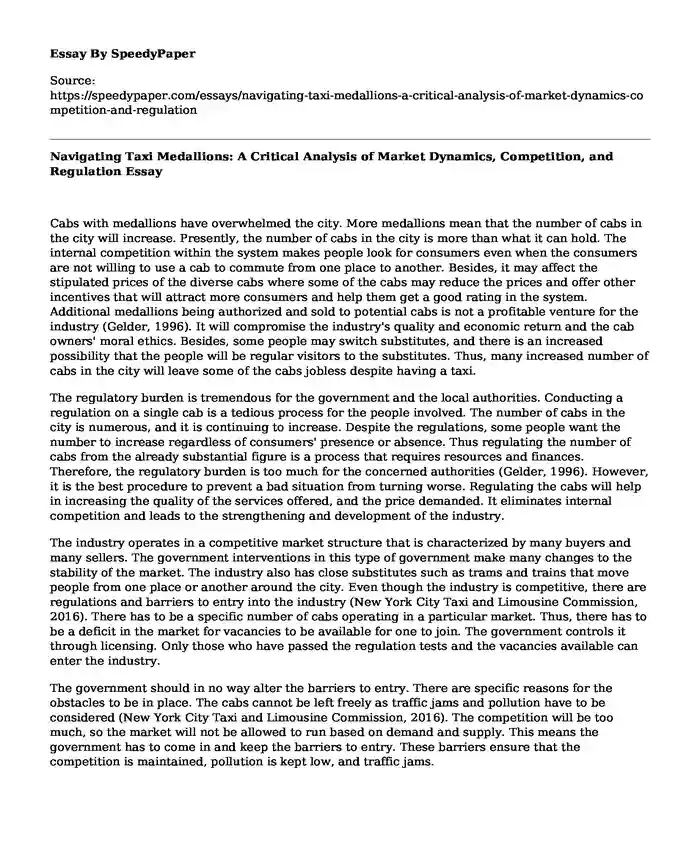Cabs with medallions have overwhelmed the city. More medallions mean that the number of cabs in the city will increase. Presently, the number of cabs in the city is more than what it can hold. The internal competition within the system makes people look for consumers even when the consumers are not willing to use a cab to commute from one place to another. Besides, it may affect the stipulated prices of the diverse cabs where some of the cabs may reduce the prices and offer other incentives that will attract more consumers and help them get a good rating in the system. Additional medallions being authorized and sold to potential cabs is not a profitable venture for the industry (Gelder, 1996). It will compromise the industry's quality and economic return and the cab owners' moral ethics. Besides, some people may switch substitutes, and there is an increased possibility that the people will be regular visitors to the substitutes. Thus, many increased number of cabs in the city will leave some of the cabs jobless despite having a taxi.
The regulatory burden is tremendous for the government and the local authorities. Conducting a regulation on a single cab is a tedious process for the people involved. The number of cabs in the city is numerous, and it is continuing to increase. Despite the regulations, some people want the number to increase regardless of consumers' presence or absence. Thus regulating the number of cabs from the already substantial figure is a process that requires resources and finances. Therefore, the regulatory burden is too much for the concerned authorities (Gelder, 1996). However, it is the best procedure to prevent a bad situation from turning worse. Regulating the cabs will help in increasing the quality of the services offered, and the price demanded. It eliminates internal competition and leads to the strengthening and development of the industry.
The industry operates in a competitive market structure that is characterized by many buyers and many sellers. The government interventions in this type of government make many changes to the stability of the market. The industry also has close substitutes such as trams and trains that move people from one place or another around the city. Even though the industry is competitive, there are regulations and barriers to entry into the industry (New York City Taxi and Limousine Commission, 2016). There has to be a specific number of cabs operating in a particular market. Thus, there has to be a deficit in the market for vacancies to be available for one to join. The government controls it through licensing. Only those who have passed the regulation tests and the vacancies available can enter the industry.
The government should in no way alter the barriers to entry. There are specific reasons for the obstacles to be in place. The cabs cannot be left freely as traffic jams and pollution have to be considered (New York City Taxi and Limousine Commission, 2016). The competition will be too much, so the market will not be allowed to run based on demand and supply. This means the government has to come in and keep the barriers to entry. These barriers ensure that the competition is maintained, pollution is kept low, and traffic jams.
Optimal Opinions
Consumers would want the cabs to be regulated. They do not want to be disturbed now and then whenever they are in the process of carrying on with their daily routines. Also, because of the industry's internal competition, the cabs will be competing for the consumers at the expense of delivering quality services. The price will not be standard. Thus, consumers want to be served in the best way possible, accounting for their monetary value. From the producer's point of view, the optimal position is minimal competition from both fellow cab drivers and substitutes, including trains and trams. Therefore, they would like to have low competition and better government support, where the business will face fewer challenges (New York City Taxi and Limousine Commission, 2016). The government's position is to ensure that the negative issues associated with cabs are reduced. They include traffic jams that may be caused by unregulated traffic in the city. Air and noise pollution also increases with an increase in the use of motor vehicles. Thus, they control these factors through increased barriers to entry.
References
Gelder, L. V. (1996). Medallion limits stem from the 30's. New York Times https://www.nytimes.com/1996/05/11/nyregion/medallion-limits-stem-from-the-30-s.html
New York City Taxi and Limousine Commission. (2016). 2016 TLC factbook. https://www1.nyc.gov/assets/tlc/downloads/pdf/2016_tlc_factbook.pdf
Cite this page
Navigating Taxi Medallions: A Critical Analysis of Market Dynamics, Competition, and Regulation. (2024, Jan 27). Retrieved from https://speedypaper.net/essays/navigating-taxi-medallions-a-critical-analysis-of-market-dynamics-competition-and-regulation
Request Removal
If you are the original author of this essay and no longer wish to have it published on the SpeedyPaper website, please click below to request its removal:
- A Plan of Action for Molson. Marketing Essay Example.
- Free Essay Sample on Hypothesis Testing Review
- Starbucks Corporation's WACC, Essay Sample for Students
- YouTube Interface Evaluation - Paper Example
- Essay Sample on a Municipal Budget
- Paper Example: Single and Two-Parent Households and the Effects on Children
- Paper Example on the UK
Popular categories





